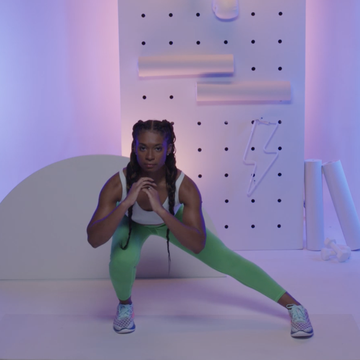Whether your goal is to gain muscle, build endurance, lose weight, or improve your overall health and wellness, chances are you want to lock in a sustainable workout plan. You also want to set yourself up for success with enough challenging sweats and time for your body to recover. Striking that balance may seem tricky, but fitness pros have some clear advice about how often you should work out—and what types of exercise you should focus on when you do.
First, you have to figure out your goals, says WH advisor Sohee Carpenter, CSCS, trainer and fitness educator. Three main buckets to consider: general health, weight loss, and building muscle.
Meet the experts:
Sohee Carpenter, CSCS, is a trainer, fitness educator, and WH advisory board member.
Kehinde Anjorin, NCSF, CFSC, is the founder of The Power Method. Rebecca Kennedy, CPT, is the director of strength for Peloton.
Natalya Vasquez, CPT, is a certified personal trainer, health coach, and founder of Bridal Bootcamp San Diego.
Whether you want to run a record number of miles, get into strength training, lose weight, or just feel healthy all over, there is an optimal number of workout days for you. Spoiler: It's probably fewer days than you think. Rest days are oh so valuable for hitting your goals, too.
The US Department of Health recommends at least 150 minutes (2 hours and 30 minutes) of moderate physical activity a week, but what you do beyond that really depends on a few key factors (more on that soon!).
Intrigued? Keep scrolling for your personalized answer to how often you should exercise (and how to create an effective workout routine) for each major goal. Goodbye confusion, hello results!
How often should you work out each week?
Your magic number of workout days depends on your goals, and here's a cheat sheet to optimize your schedule:
Weight loss: 3-5 days/week
Building muscle: 3-5 days/week
General health: 3-6 days/week
If you’re aiming for weight loss you can sustain long-term, three or four days per week gives you enough flexibility that you can stay on track week after week and month after month. In many cases, healthy, sustainable weight loss is best achieved through a combo of exercise and both nutrition and behavior changes.
“For weight loss, working out three to four times per week is optimal,” explains trainer Kehinde Anjorin, NCSF, CFSC, founder of The Power Method. “Long-lasting weight loss has no finish line, so you want to be able to maintain and prioritize this lifestyle to keep your results.”
But another crucial factor for weight loss is being more active in general—even outside of formal workouts. “Generally, those who maintain higher activity levels (even if not in the form of formal exercise but in other activities such as walking while doing errands) tend to be more successful at maintaining weight loss,” Carpenter says. “They burn more calories throughout the day and expend more energy overall.”
TL;DR: In addition to penciling in workouts, try to make daily routine changes that get you up and moving more. It'll pay off in the long run.
Just note that nutrition is equally important to how many days you work out when it comes to weight loss, says Natalya Vasquez, CPT, a certified personal trainer, health coach, and founder of Bridal Bootcamp San Diego. “You can work out all you want, but if you're eating over your body’s caloric needs and if the type of foods you’re eating are ultra-processed foods instead of nutrient dense whole foods, you may have a more difficult time losing weight and keeping it off,” she explains. “Eating nutrient dense whole foods will fuel your body with the nutrients it needs to support feeling good both physically and mentally.”
Three or four workouts per week is also a great place to start if you want to sculpt some muscle, but how you spend your time during those workouts will be a little different than if you're sweating for overall health or to lose weight, Anjorin says.
If your priority numero uno is overall health, you can base your specific workout routine on what you enjoy—and just how much of your free time you want to spend sweating.
“Generally speaking, I think anywhere between three to six days a week works for most individuals,” says Carpenter. “The more sedentary you are in everyday life, the more I recommend doing some form of intentional movement most days.” If your job requires long hours at a desk, for example, you'll benefit more from incorporating exercise every day. If you have a more physically demanding job, though, closer to three workouts a week might cut it.
And, if you're in race mode and aiming for a marathon or half marathon, check out these comprehensive training guides for running your first or fastest marathon and half marathon.
Types Of Exercise To Choose From
Cardio: Also known as aerobic exercise, cardio is any activity that increases your heart rate and strengthens your heart and lungs, says Vasquez. “It is so much more than running,” she explains. “Cardio can be low impact walking, swimming, a dance class, kickboxing, pickleball, rollerblading, or bootcamp,” she adds. The American Heart Association recommends a minimum of 150 minutes of moderate-intensity or 75 minutes of high-intensity cardio per week, ideally spread throughout the week, but cardio should be programmed into your routine in a way that supports your goals, says Vasquez.
Strength training: Resistance training helps strengthen your muscles and includes lifting weights, using resistance bands, medicine balls, or weight machines. “If your goal is to put on muscle or lose body fat, then you should strength train three to five times per week for approximately 30 to 60 minutes per session,” says Vasquez. “This amount of training will allow you to train multiple muscle groups effectively to ensure a well-balanced training program.” This may include an hour-long strength-based workout class or a 30-minute sweat sesh during your lunch break, she adds.
Mobility: Mobility refers to the range of motion in your joints and their ability to move freely, and should be incorporated into every training session, says Vasquez. “These exercises can be added into your warmup with your dynamic stretches, and if you’re doing resistance training, can also be spread throughout your workout before lifting heavier weight,” she explains. Examples include shoulder circles, hip openers, and cat cows.
Balance: Balance is being able to control your body during movements and activities, and to keep your body in position while remaining static. “Balance training is oftentimes completely disregarded when it comes to training, but as we become older it's actually more important to our bodies,” says Vasquez. Balance exercises can be incorporated into a longer session or done on their own for 10- to 15-minutes a few times a week with moves like single-leg stands, marching in place, and alternating reverse lunges, she adds.
What's an effective workout routine?
As for how to craft your formal workouts to hit those goals? Let's discuss.
Cardio: 2 Days Each Week For Weight Loss, Up To 1 Day Each Week For Building Muscle
Though you might think that losing weight requires doing loads and loads of cardio, good news: "Long gone are the days of prescribing excessive cardio for weight loss,” says Anjorin. “Incorporating resistance training is more beneficial and effective for weight loss."
Incorporate about two days of cardio per week to support your weight loss, Anjorin recommends. From there, add (or subtract!) cardio sessions (running, swimming, HIIT, kettlebell swings, etc.) based on how you feel afterward and your progress. In short, cardio can really be whatever type of aerobic exercise that you like as long as it gets your heart rate up. If you don't enjoy it, you won't stick with it, so finding types of cardio and other exercise you really enjoy is ultimately your golden ticket. Keep in mind that more isn't better, though. "When it comes to weight loss, you want to make your body as efficient as possible by building muscle (and not burning it off)," adds Vasquez.
Consider this your invitation to ease up on the cardio workouts for more muscle, too: “I would suggest scaling back on the cardio when muscle building is the goal,” says Carpenter.
To get your heart pumping and preserve those muscle gains, stick with one HIIT workout, cycling class, or other harder session per week, suggests Rebecca Kennedy, CPT, director of strength for Peloton. “When your goal is to build muscle, cardio should be supplemental and used for general conditioning and endurance,” she says. “It should come after strength work and be mostly low-intensity so you can build endurance without cannibalizing the efforts of your strength workouts.”
In this case, too much intense cardio can impact your muscles' ability to recover from and adapt to strength training, ultimately stunting their growth.
Strength Training: 3 Days Each Week For Weight Loss, 3-4 Days Each Week For Building Muscle
Strength training is your BFF if you’re trying to lose weight, says Anjorin. Her recommendation: Start with three strength training days per week. “Start small using light or moderate weights and build from there,” she adds.
Then, continue to stress your muscles (and see the greatest benefits) by increasing the amount of weight you use at least every few weeks. Not sure which movements to start with? Try moves such as squats, pushups, and deadlifts, which use multiple large muscle groups and burn more calories, says Anjorin—which ultimately helps lead to weight loss. (Exercises that isolate smaller muscles don't offer as much bang for their buck.)
No surprise here: Strength training is *definitely* a must if you want to build that muscle, too, Anjorin says. Ideally, that means three to four strength workouts per week.
Compound movements like squats and deadlifts that fire up multiple big muscle groups are still the way to go here. However, progressively lifting more weight and tweaking your nutrition are extra important for building muscle.
“In order to build muscle, you have to keep progressing your load and challenging your muscles to grow,” says Anjorin. (Shoot for a weight you can lift for just about 10 to 12 reps to maximize that potential!) “Increasing protein intake and calories are also often overlooked, but without the appropriate nutrition, it's hard to build any muscle mass,” she adds. Make sure to incorporate protein into every meal—especially those you nosh on before and after hitting the weights.
Is it bad to work out every day?
Short answer: yes. Rest days are just as important as your workout days and you need them on your schedule to hit your goals.
Rest: 2 Days Each Week For Weight Loss, 2-4 Days Each Week For Building Muscle
You need to balance work and rest to get the results you want and sustain your routine. That applies to any goal.
"Rest days can vary from individual to individual, depending on your training schedule and workout intensity, sleep hygiene, and food quality,” Anjorin says. That being said, taking two rest days per week generally works well when weight loss is your goal, as it ensures you have the recovery you need to push your body when you do get moving.
Of course, though: “Always listen to your body,” says Anjorin. If you’re feeling tired, there’s no reason *not* to take a chill day. Remember, losing and maintaining weight is a marathon, not a sprint.
If building muscle is your MO, you may need to take more rest days. “The muscle needs to be stimulated and also have time to recover and then adapt,” says Kennedy. “We want to avoid both overtraining and under-training muscles.”
Depending on how new you are to strength training and how hard you push yourself, Kennedy recommends between two and four days sans weights per week for building muscle. “With too little rest, the body doesn't have the proper time to recover for your next workout,” she explains.
Again, your body will let you know what to do here. If you feel more tired than usual when ramping up your strength training, give yourself an extra rest day or two so those muscles can bounce back (and grow!).
For overall health, mix in both strength and cardio.
If you're working out to feel good, don't worry too much about how much cardio versus strength training you do in a given week.
"As a general rule for the general population, a 50-50 training split is a great starting point,” says Anjorin. That means that if you work out four days a week, you'd do two days of strength training and two days of cardio and three rest days. Easy-peasy, right?
Bottom line: How often you should work out depends on your lifestyle, fitness level, and individual goals. But ultimately, balancing cardio and strength sessions and recovery is key whether you're working out for overall health, weight loss, or building muscle.












